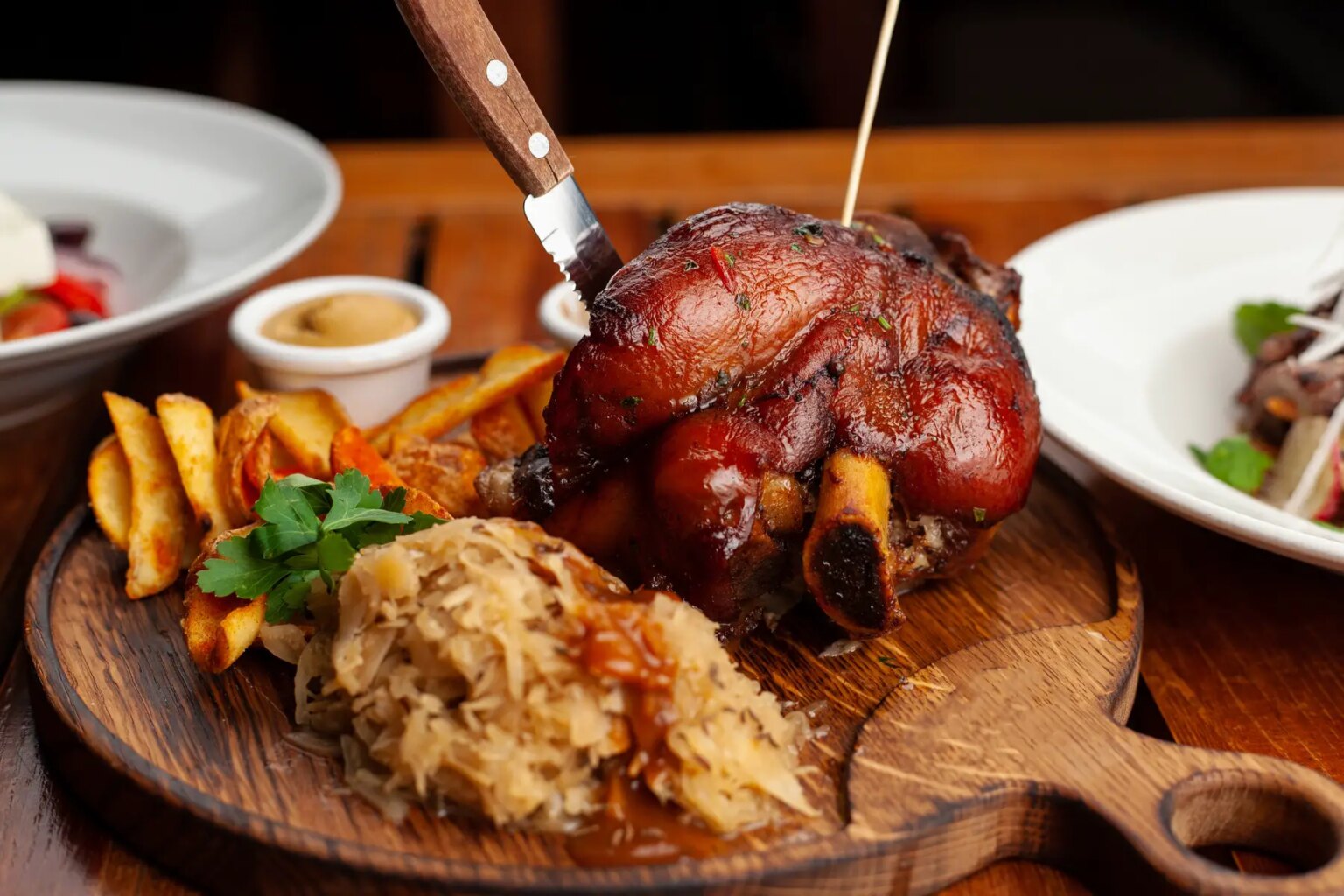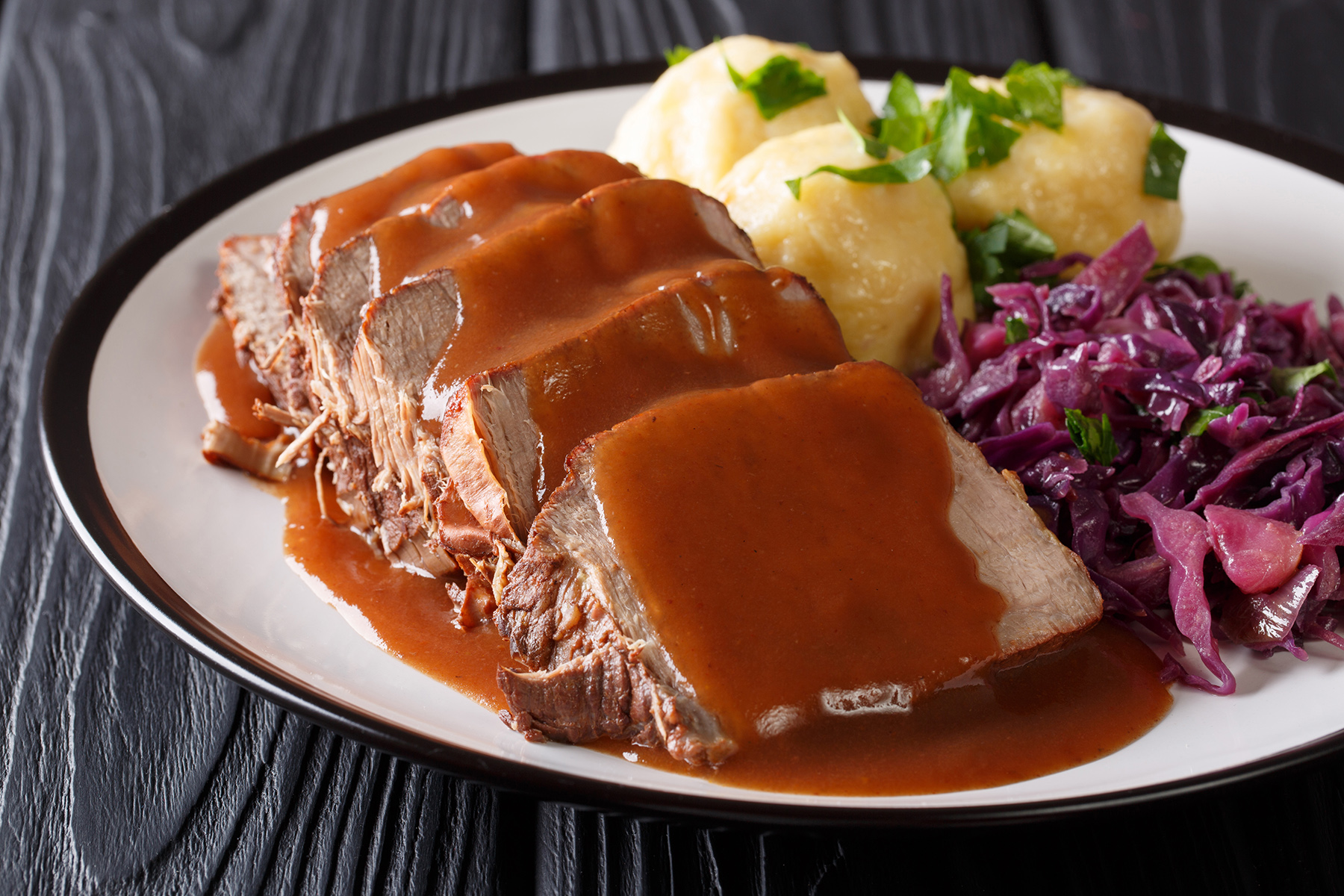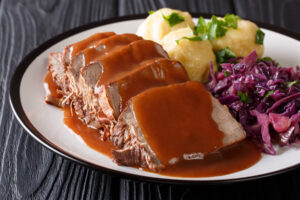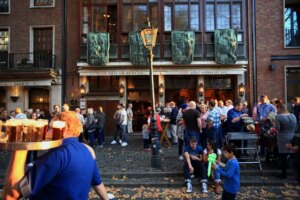While German cuisine might be associated with two things – potatoes and sauerkraut – there is actually much more to it than meets the eye. In fact, the German kitchen is incredibly diverse and draws on inspiration from Polish, Turkish, and Jewish cooking traditions, among others.
It is also heavily regional in nature, with each state (Bundesland) featuring its own favorite dishes. From Lapskaus in the north to Maultaschen in the south, it’s surprising just how varied German food can be.
To give you an idea of what culinary treasures are in store, this complete guide to German cuisine includes the following information:
An overview of German cuisine
German cuisine has a reputation for being bland and uninspired. This may have been true of the early Germanic tribes, who mostly ate barley, wheat, dairy products, various meats. However, over time, the German diet became more diverse and began to include more ingredients. These included things like grapes, which were used to make wine, and other fruits and vegetables. Additional cereals such as rye were also added later, most probably by the Romans. These days, spelt and rye are also hugely popular cereals that people mostly use to make a wide variety of German bread.
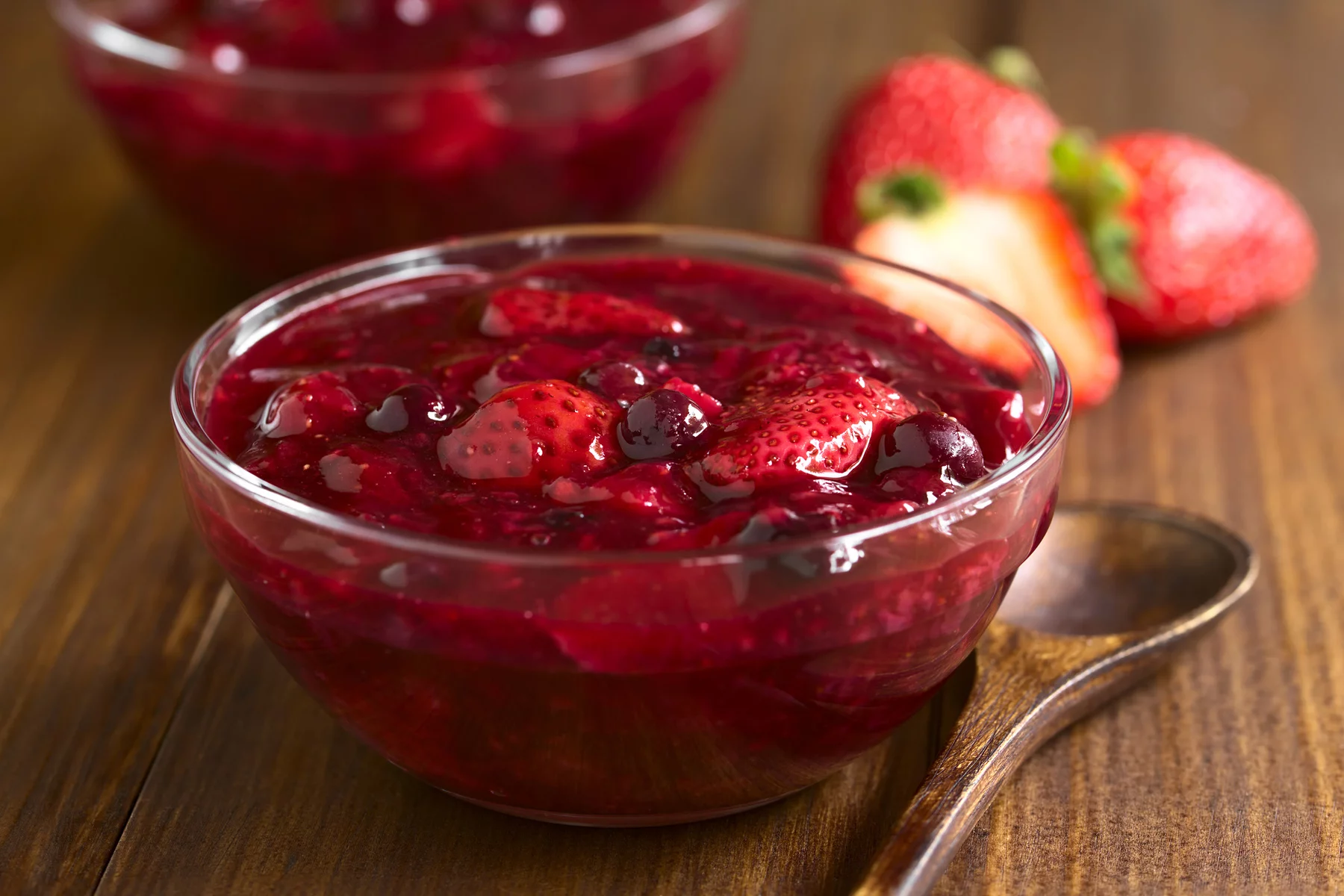
While modern German cuisine is lighter and more varied, it still falls back on the country’s rich tradition of using seasonal foods, such as Grünkohl (a kale dish) in the winter and rote Grütze (a red berry sauce) in the summer.
The organic food movement
Germany is also at the forefront of the Biobewegung, the bio (organic) food movement. This was introduced in the 1980s by those who were concerned about saving the environment and living more sustainably. They started thinking of a different way to grow produce without using insecticides or other harmful chemicals.
The Biobewegung grew out of another movement concerned with health and fitness: Lebensreform (life reform). These days, the Bio-Label is present pretty much everywhere in Germany and there are even special supermarkets or shops (Reformhäuser) that only sell organic products. At the other end of the spectrum, however, Germany still has plenty of frozen and instant food products.
Dr. Oetker is a now-ubiquitous brand that started producing baking powder in the late 19th century but has since expanded to sell everything from cake decorations and vanilla sugar to frozen pizza. Another known food giant is Knorr which began by making instant bouillon in the form of cubes. Due to a growing immigrant population from Türkiye and Italy, among other countries, Germany is also becoming increasingly international in its eating habits. The incredibly popular Döner kebab is a prime example of this trend. Ironically, while it was heavily influenced by Turkish cuisine, it was actually invented in Berlin.
The German diet
Germany has a reputation for having rather bland and unhealthy fare. However, surprisingly, statistics show a less bleak outlook. According to Eurostat, the country is actually on the lower end of the obesity spectrum. Furthermore, contrary to what you might expect, Germans tend to be extremely health-conscious and enthusiastic about sports; especially soccer, jogging, and cycling.
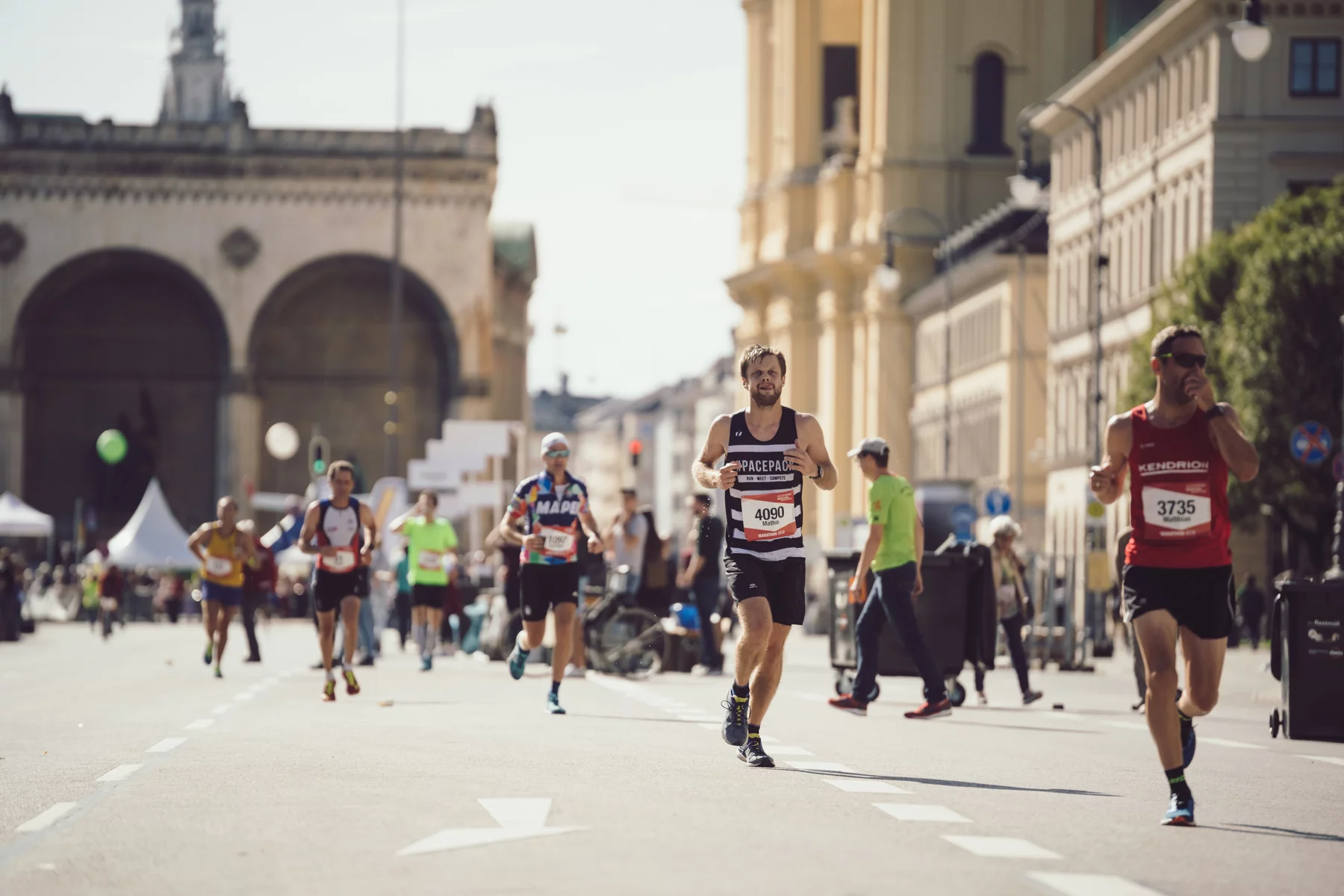
They also care deeply about the quality and origins of their food. In fact, in many countries, organic foods, such as dairy products, fruits, and vegetables actually come from Germany.
Breakfast in Germany
Germans usually eat Frühstück (which literally means ‘early piece’), around 07:30. However, in some states, including Hamburg and Bremen, people enjoy their first bite at almost 08:00. A typical German breakfast consists of Brötchen (bread) or buns served with various spreads such as cheese, ham, or jam. Sometimes, the more health-conscious Germans enjoy vegetable spreads, too. Some also like to eat cereals with milk for their first meal of the day. Coffee is also the most popular breakfast drink across the country.

Lunch in Germany
Lunch (or Mittagessen) is the most important and filling meal of the day in Germany and is usually warm. This typically includes some sort of meat, served with the country’s favorite side dish: potatoes and vegetables. This is also the time to indulge in some regional specialties such as Spätzle (Swabian noodles) or Knödel (potato dumplings), either as side dishes or as the star of the show. Because they are early risers, Germans like to eat their lunch between 12:00 and 13:00. Many children and adults also enjoy a small dessert with their lunch, such as a little bowl of yogurt with jam.
Dinner in Germany
Interestingly, bread is such an important part of German food culture that Germans even call their dinner Abendbrot, which literally means ‘evening bread’. Unlike in some other European countries, people in Germany usually eat a cold dinner. This might include slices of bread with ham, cheese, or vegetable spread and actually, look like a repetition of breakfast. This is because Germans consider eating more than one warm meal a day to be a bit of a luxury. Although most people eat their Abendbrot between 18:00 and 20:00, this is gradually changing and many Germans prefer to have a warm meal after coming home from work. This might consist of Schnitzel, Bratwurst with sauerkraut, or another popular German dish. As a result, dinner is slowly becoming the main meal of the day in the country. People also consider it a time to relax after a stressful day at work.
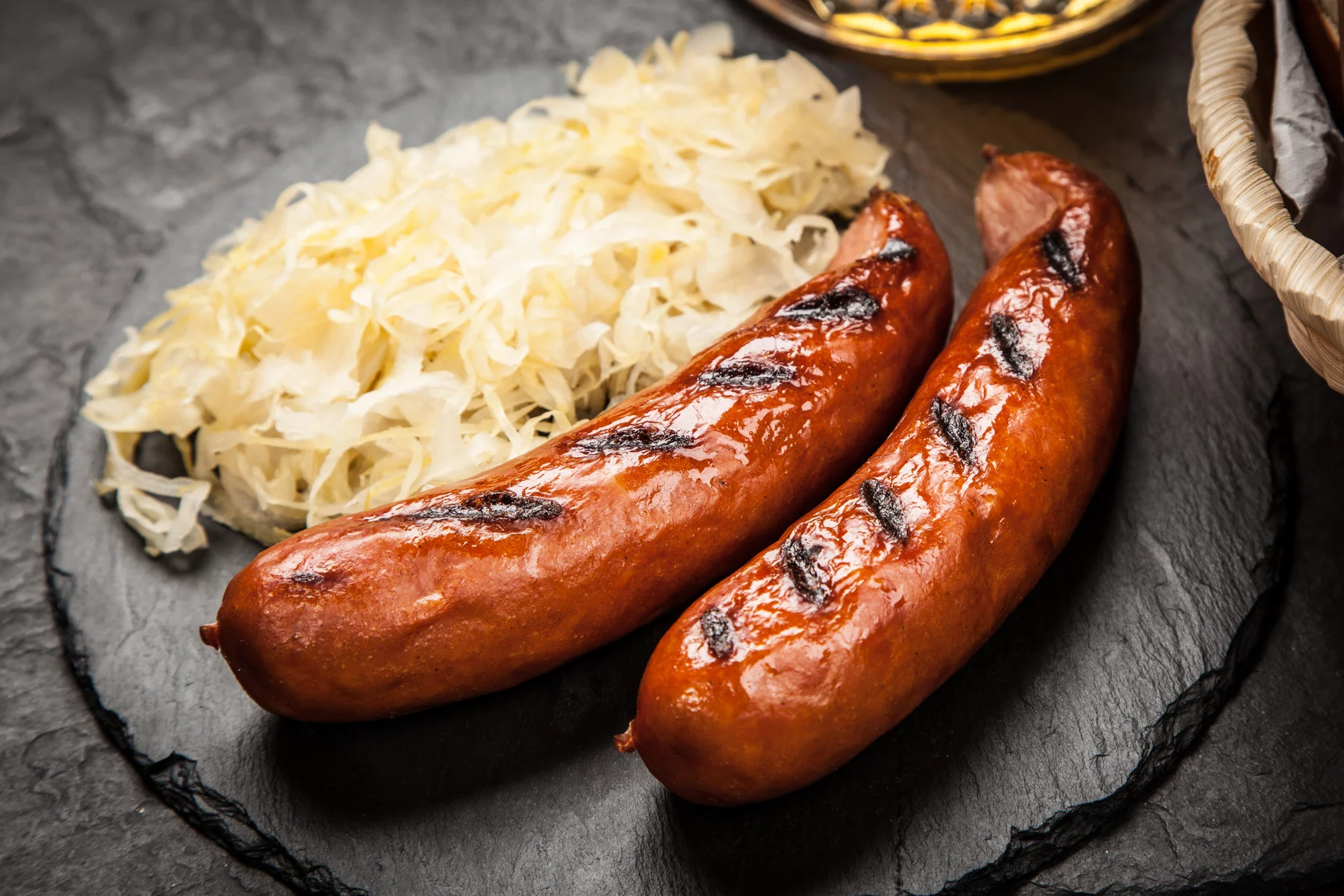
Snacks in Germany
Germans tend to eat three meals a day but sometimes, they make an exception for Kaffeezeit, which literally means ‘coffee time’. Also referred to as Kaffee und Kuchen, (coffee and cake), this is when – as the name suggests – people enjoy a coffee with a slice of cake. They typically do this at 15:00, however, many people in north Germany also have tea with a snack at around 11:00. People call this Elführtje in the regional dialect.
By contrast, Bavarians and Swabians have turned a snack into a proper meal called Brotzeit. This is the epitome of Bavarian Gemütlicheit, or coziness, and is typically eaten at around 15:00 with friends. It usually includes various types of bread (preferably rye bread with caraway seeds) and pretzels with meats, cheeses, salads, and vegetables. In Bavaria, people also call a snack a Vesper which comes from the state’s Catholic tradition and refers to the penultimate prayer or mess before the night.
Special meals in Germany
Like all nationalities, Germans have a range of special meals that they enjoy at particular times of the year to mark certain occasions. Below are some of the most traditional ones that you may come across.
Christmas dinner
While Americans love to eat turkey, and other countries prefer fish, Germans typically opt for goose at Christmas time. They usually serve this on Christmas Eve along with potatoes, baked apples, and a sauce made from the drippings. Sometimes, the goose also comes with potato dumplings and red cabbage (Weihnachtsgans mit Klößen und Rotkohl). Then, on Christmas Day, many people throughout the country enjoy a meal of sausage and potatoes or seasonal dishes such as venison roasts.

Christmas treats
During the four weeks of Advent, many Germans like to eat little cookies called Plätzchen. These come in different shapes and flavors, but the most popular are Vanillezipferl, which are made with almond flour and vanilla sugar and shaped like half-moons. Another popular festive treat is Stollen, a type of yeast bread that is baked with dried fruits, candied citrus peel, nuts, and spices. A dusting of powdered sugar over the top also makes it look like snow. While there are several variations of the recipe, one of the most common is Marzipanstollen, which contains marzipan.
Easter breakfast
An Easter breakfast in Germany wouldn’t be complete without eggs. These are usually served in omelets or are cooked and dyed. For fun, parents also hide eggs around their gardens for their children to find. Like always in Germany, bread plays a key role in the celebrations and people like to eat special types of bread, such as Hefezopf (a plaited yeast loaf) and Challah (which is Hebrew for ‘loaf’), around this time of year.
Easter dinner
Good Friday is a day of fasting in Germany and so meat is usually missing from the dinner table. However, fish – most commonly Kabeljau (cod) – takes center stage. The Easter Sunday meal includes Lammbraten (baked lamb) or baked ham. Swabians love eating Maultaschen around this time of year, too. These are dumplings containing spinach and meat; the spinach is there to hide the meat which is why they are usually eaten on Good Friday.
New Year’s Eve food traditions
While counting down to midnight on New Year’s Eve, German people often enjoy Krapfen or Berliner. These are fried doughnuts filled with either jam, vanilla, chocolate custard, and various other things.

Raclette is another popular dish that many people like to eat around this time. Based on the cheese of the same name, this traditional dish is accompanied by potatoes and cucumber or vegetables and meat. And, of course, no winter meal would be complete without Glühwein.
Popular ingredients in Germany
German cuisine incorporates a wide variety of fresh, seasonal, and regional ingredients. Regionality also plays a huge role when it comes to the types of food and cooking methods used throughout the country. Sustainability is also important to Germans, who took the lead in the bio (organic food) movement in the 1980s. Interestingly, Germany also has some ingredients, vegetables, and herbs that are practically unknown anywhere else.
Meats
Germans are known to be intensive consumers of meat. Schweinefleisch (pork) is the most popular meat in the country, followed by Hänchehfleisch (chicken) and Rindfleisch (beef). As well as eating meat fried, baked, or boiled, people also enjoy it in the form of hams, pâtés, and sausages (Wurst and Würstchen). Below are some other popular meat products in Germany:
- Frankfurter – a longer and thinner type of sausage
- Knackwurst – what is commonly known as Berliner wurst in other countries
- Wienerwurst – another type of sausage
- Mettwurst – a raw, smoked ham often eaten on bread for breakfast
- Kassler – a type of smoked pork meat that can be eaten baked, cooked, or raw. It is often eaten in Grünkohl (which means kale but actually refers to a whole dish).
- Döner kebab – the streetfood of choice for many, whether in the middle of the afternoon or after a heavy night in the clubs.
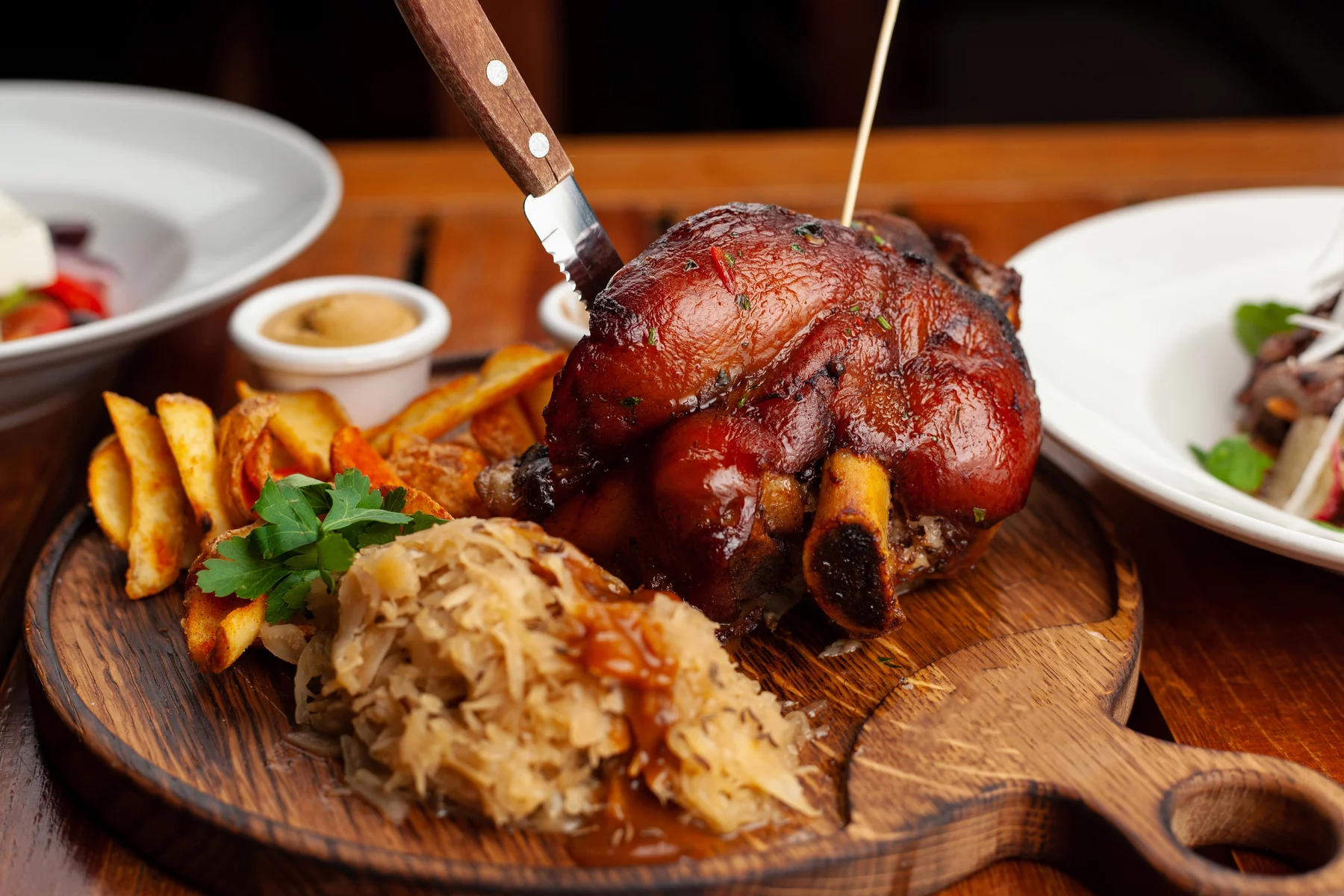
- Schweinhaxe (pork knuckle) – this is probably the most famous Bavarian dish and typically comes with potatoes and cabbage
- Sauerbraten (literally sour bake) – this is made from beef and typically heavily marinated and baked low and slow over two or three hours. It is usually served with potato dumplings or pancakes (latkes).
- Frikadellen (meatballs) – these are popular all over the country and are called Bouletten in the north. Mettbrötchen are buns that are served with raw meat and onions. These are hugely popular, especially in Hamburg.
- Rehrücken (deer back) – this is often baked whole and served with Spätzle and jus. Wild (venison) is often served in restaurants all over Germany, as well as Wildschwein (boar), Reh (deer), and Hase (hare).
Fish
Fish is another German staple. The most common varieties include cod, (Kabeljau or Dorsch), Hailbutt (halibut), Lachs (salmon), and Herring (herring). While saltwater fish is popular in the north of the country, people in the south generally prefer freshwater fish such as Forelle (trout). Karpfen (carp) remains a popular choice as well. Some of the most common fish dishes in Germany include the following:
- Kieler Sprotten – a typical delicacy consisting of smoked sprat, a tiny fish commonly sold in metal boxes, packed closely together.
- Labskaus – a popular dish from the cities of Hamburg, Bremen, and Lübeck, which combines fish – particularly herring – with corned beef, beetroot, gherkins, and egg.
- Fischfrikadellen – also called Fischbouletten, these fried fish balls are believed to be a precursor to the modern American hamburger!
Vegetables
While German cuisine is rather meat-heavy, it does manage to incorporate a wide variety of seasonal and regional vegetables. For instance, asparagus, various types of cabbage, and other root and tuber vegetables such as carrots, turnips, and radishes take center stage during a German meal. Farmers’ markets are, therefore, incredibly popular throughout the country and often sell fresh home-grown or organic produce. Germans also happily eat cucumbers and tomatoes.
Here are some other popular vegetables and dishes that you are likely to find in kitchens across Germany:
- Spargel (asparagus) – is probably the most popular of all German vegetables. This refers to the white and thick stalks rather than their green and thin counterpart. Spargelzeit (or asparagus season) lasts from April until late June. In Germany, people eat Spargel with potatoes, ham, Hollandaise sauce, and sometimes, a fried egg.
- Kartoffelpuffer – also known as Reibekuchen, these fried pancakes are made from ground raw potatoes and are often eaten with apple sauce
- Knödel – these round potato dumplings can be eaten sweet (filled with plums) or savory (with meat)
- Kartoffelsalat – this typical German potato salad doesn’t include eggs or mayonnaise but instead potatoes, vinegar, and stock

- Rotkohl – Germans typically eat cabbage boiled and with apples for a slightly more sour taste
- Kohlrabi – this healthy vegetable that resembles sputnik can be eaten raw or cooked with a cream sauce
- Kohlrouladen – this dish consists of ground meat and rice wrapped in savoy cabbage leaves
- Sauerkraut – Germans also love fermenting their cabbage, resulting in sauerkraut, which is often served with pork meat in Bavaria
- Grünkohl (kale) – this is usually eaten in a dish of the same name, along with kale, sausage or ham, and potatoes
Fruits
Generally speaking, Germans love fruit, especially locally produced ones such as strawberries and other berries. Because strawberry season coincides with asparagus season, you will often come across little pop-up stalls selling both. Strawberries are used in jellos (Götterspeise or Wackelpudding, depending on the region), jams (Konfitüre or Marmelade), and cakes. Other berries are also used in pastries, jellos, and juices. These include raspberries (Himbeeren), blackberries (Brombeeren), bilberries (also called European blueberries or Heidelbeeren in German), red and black currants (rote Johannisbeeren and schwarze Johannisbeeren).
Here are some popular German dishes and drinks that are made from various fruits:
- Rote Grütze – a fruit pudding made from berries and potato starch which is used as a thickening agent
- Rhabarberkompott (rhubarb compote) – while rhubarb is technically a vegetable, it is commonly used in sweet dishes such as jams and tarts, as well as a drink called Schorle
- Grüne Grütze – a fruit pudding made from potato starch and green-colored fruit such as gooseberries or kiwi
- Apfelschorle – apple juice is the most popular fruit juice in Germany and is often mixed with carbonated water to make this popular soft drink
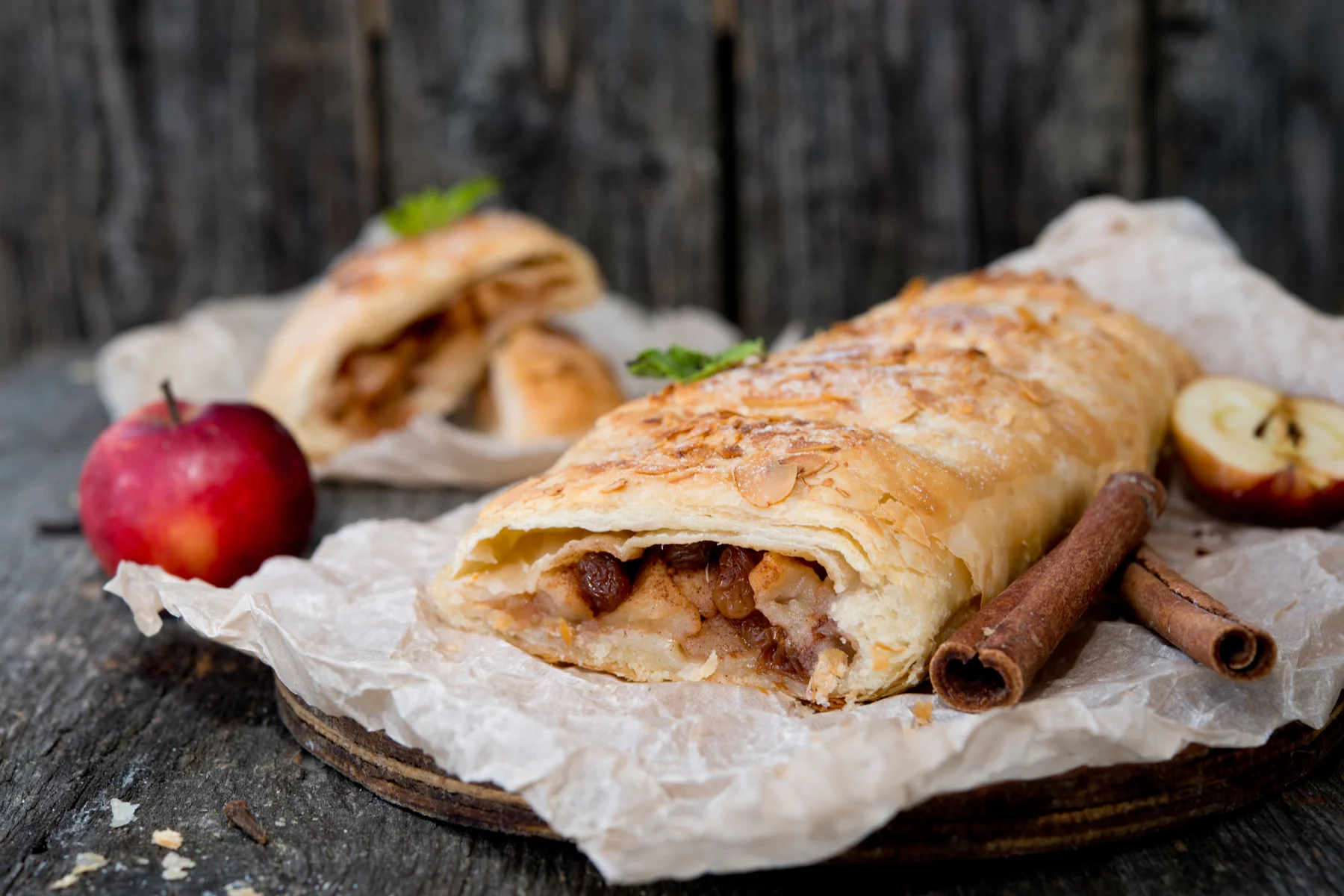
- Apfelstrudel – a flaky apple pie that is very popular in the southern part of Germany and often served with vanilla custard
- Schwarzwälder Kirschtorte – known as ‘Black Forest Gateau’ in the UK, this popular German dessert includes Sauerkirschen (sour cherries) which can also be found in preserves made for cakes
- KiBa (short for Kirsche Banane) – a popular smoothie made with bananas, cherries, and milk
Carbohydrates
Bread is a mainstay in German cuisine and the country is a leading producer of it. In fact, there are around 300 different types of bread in Germany. These incluce Roggenbrot (rye bread) in the north and Dinkel-und-Weizenbrot, wheat and spelt bread, which is often made with Kümmel, or caraway seeds. Graubrot is another type of grey, mixed bread, which is made with wheat and rye flour.
Here are some of the most popular carb-based snacks in Germany:
- Brezel – the Brezel (pretzel) is a type of baked pastry that is made from dough shaped into a knot. These are popular snacks to eat with German beer and you’ll find them in bakeries and street stalls across the country.
- Laugenbrötchen – these pretzel buns are another popular snack
- Spätzle – Germans love their pasta and other dumplings, especially Spätzle, a specialty from Schwabia, Knödel (potato dumplings), and Maultaschen (dumplings from Schwabia that are filled with spinach)
- Pfannkuchen – these German-style pancakes are bigger and thinner than the American version, but slightly thicker than French crêpes
- Damfnudeln – in the north of Germany, these steamed buns are eaten savory and served with stews, while in the south, they are served sweet with plum sauce and vanilla pudding
Cheese and dairy products
While Germany is not exactly considered to be a ‘cheese country’, its wide range of dairy products is quite impressive. Here are some of them:
- Obazda – a type of cheese spread that consists of soft cheese such as camembert and butter, which is most prevalent in Bavaria
- Quark – a type of soft, tangy farmer’s cheese that is used in cakes and pastries

- Molke – Germans love to drink whey and often adding extra flavors
- Trinkjogurt – a yogurt drink that comes in a variety of flavors
- Ayran – Turkish in origin, Ayran is a yogurt drink consisting of water, salt, and garlic, and is popular in Dönerladen (kebab shops)
Herbs and spices in Germany
Here are some of the most common herbs and spices that you are likely to come across in German kitchens:
- Bärlauch – wild garlic or ransoms, used in bread, spreads, and pesto
- Waldmeister – a sweet, herbaceous green plant, woodruff grows in the forest and is used in jellos, syrups, and ice cream
- Dill – dill
- Thymian – thyme
- Rosmarin – rosemary
- Kümmel – caraway
- Senfsaat – mustard seeds
- Wacholderbeeren – juniper berries
The most famous German dishes
Believe it or not, there is far more to German food than sausages and sauerkraut. On the contrary, the country boasts a delicious array of rich and hearty dishes that are great comfort food. Below are some German classics.
Rouladen
This typical German dish consists of bacon, onions, mustard, and pickles wrapped in thinly sliced beef or veal which is then cooked. While the recipe varies from region to region, beef has become popular over the last century. The cut is usually topside beef or silverside since this is the cheaper cut. You will find this hearty German food at festivals and family dinner tables across the country. It usually comes with dumplings, mashed potatoes, Blaukraut (cooked red cabbage), and red wine gravy.
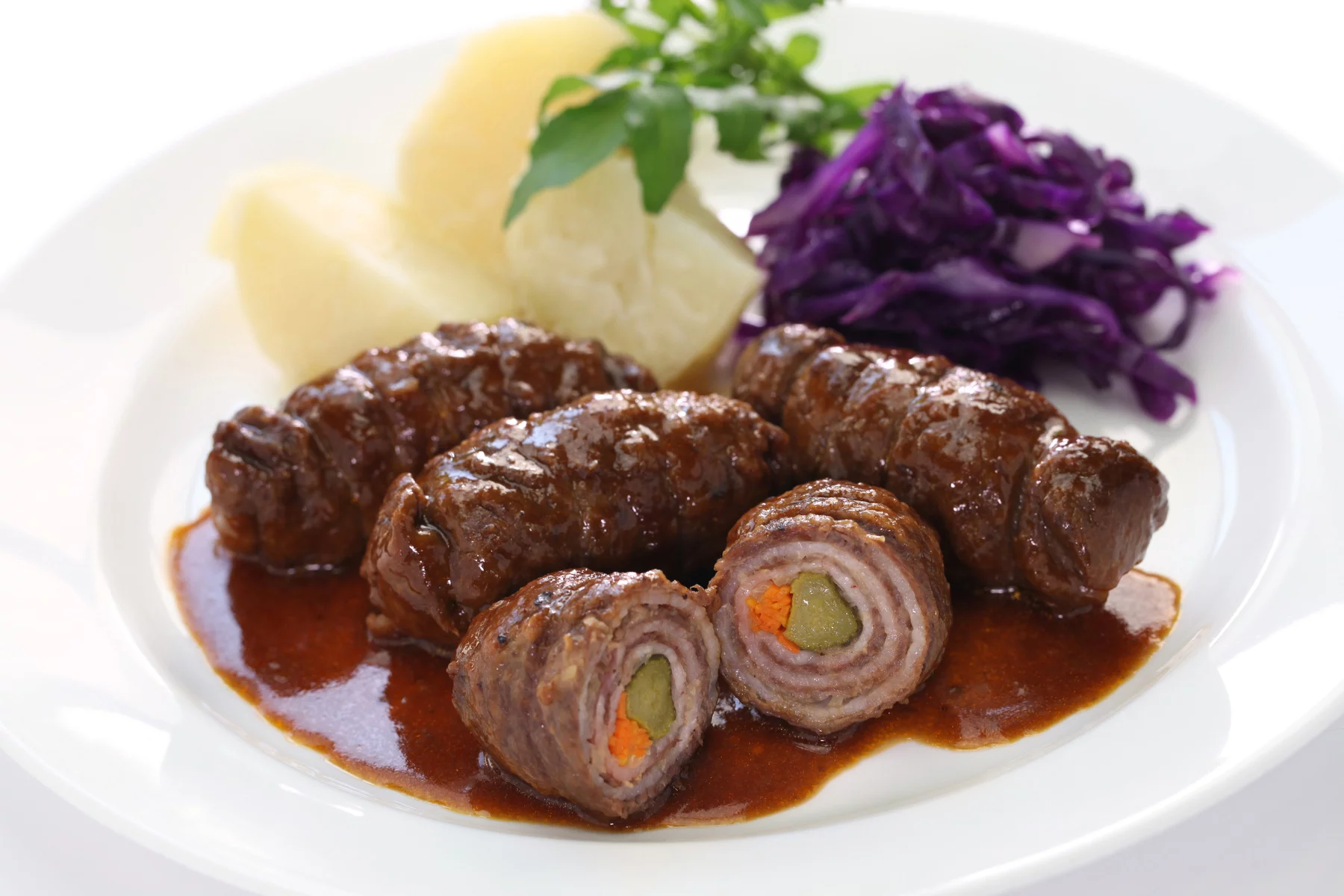
Käsespätzle
Germany’s answer to pasta, Spätzle are soft egg noodles from wheat flour and egg, often with a cheese topping (Käsespätzle) and roasted onions. Spätzle is actually a Swabian specialty and often served with meat dishes that use a lot of sauce or gravy, such as Rouladen, or in stews, such as Gaisburger Marsch (a Swabian stew).
Schnitzel
Of course, Schnitzel is an iconic part of German cuisine and comes in several different varieties. Coated in breadcrumbs, often with a slice of lemon on the side, this thin, boneless cutlet of meat is available practically everywhere in the country. Varieties include the Wiener Schnitzel (Viennese style) made from veal, the Schnitzel Wiener Art with pork (Schwein), and the Schnitzel Hamburg, which comes with a fried egg on top.
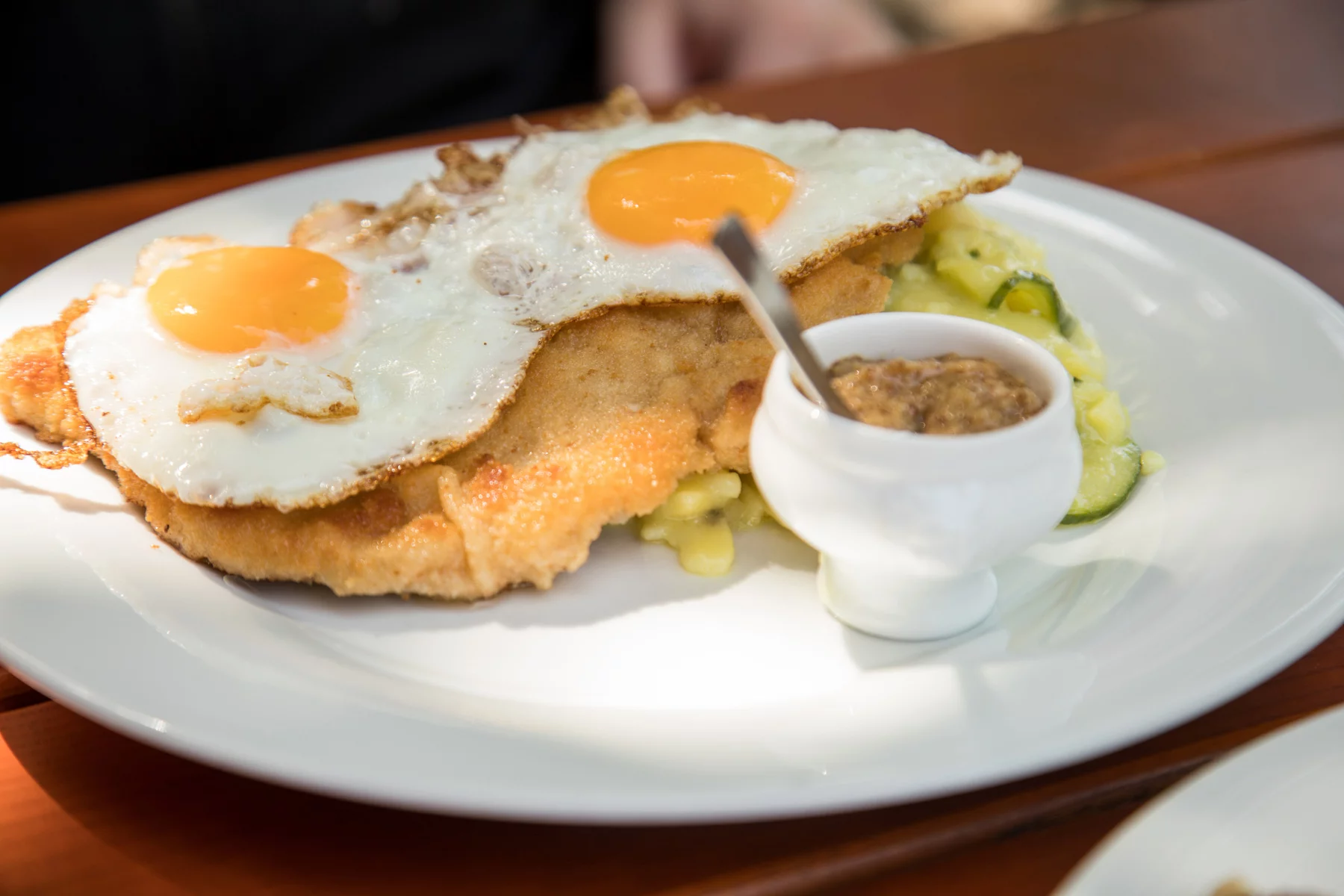
Wurst
There are around 1,500 varieties of sausage in Germany, which each come with their own preparation methods and range of ingredients and unique spices. One of the most popular varieties is Bratwurst, a pan-fried or roasted sausage made from veal, beef, or pork. Others include Wiener (Viennese), which is smoked and then boiled, and the blood sausages, Blutwurst and Schwarzwurst. You will also find regional specialties such as Berlin’s Currywurst (with curried ketchup on top) and Bavaria’s Weisswurst, a white sausage that you peel before eating with sweet mustard. You will find these on street stalls almost everywhere across the country.
The most famous German desserts
There are several iconic desserts that people love to enjoy throughout Germany. Below are some of the country’s most famous sweet dishes.
Schwarzwälder Kirschtorte
Arguably Germany’s most famous cake, the delicious Schwarzwälder Kirschtorte (which literally means ‘Black Forest cherry torte’) gets its name from Schwarzwälder Kirschwasser, a liqueur distilled from tart cherries. German law actually mandates that Kirschwasser must be present in the cake for it to earn the name Schwarzwälder Kirschtorte. Alternating layers of rich chocolate cake, cherries, and whipped cream are topped off with more cream, maraschino cherries, and chocolate shavings for a luxurious finish.
Bienestich
Literally translating as ‘bee sting cake’, this popular German dessert is made of sweet yeast dough with a baked-on topping of caramelized almonds and a vanilla custard, buttercream, or cream filling. As one story goes, German bakers created a version of it back in the 15th century after successfully warding off raiders from a neighboring village by throwing beehives at them. Whether or not this is true, though, this is a delicious treat that many people enjoy as part of their Kaffe und Kuchen in the afternoon.
Baumkuchen
Literally meaning ‘tree cake’, this popular dessert takes its name from its unusual appearance, which resembles the rings of a tree when you cut it. People consider it to be very special because of how it is made. Essentially, thin layers of cake batter are spooned onto a rotating spit and then baked over a fire. New layers of batter are then spread on the baked ones until the cake is thick enough and the spit is removed and the cake is cut to reveal the inner rings. Traditionally, there are 21 layers in a Baumkuchen.

Apfelstrudel
The Apfelstrudel (apple strudel) consists of buttery pastry full of apples, sugar, cinnamon, and raisins. The dish became popular in the 18th century under the Habsburg empire. You can make the delicate flakey pastry from an elastic dough, which you knead and stretch until it is almost paper-thin. You then butter the thin pastry layers together, before wrapping them around the apple filling and baking it. It is common to eat the dessert in slices with a sprinkling of powdered or icing sugar.
Regional differences in German cuisine
Each region in Germany has its own recipes, cooking methods, and flavors that contribute to the country’s rich and hearty cuisine. Below are some of the main culinary regions in Germany.
Schleswig-Holstein
Schleswig-Holstein is Germany’s northernmost state. The cuisine of the region tends to combine sweet and salty flavors and relies heavily on fish and seafood. Some classic dishes include the following:
- Kieler Sprotten – a type of German smoked sprat that belongs to the herring family and inhabits the Baltic Sea
- Noordseekrabben – a variety of small shrimps that inhabit the North Sea off the coasts of Germany
- Holsteiner Sauerfleisch – a type of sour meat that is a specialty of Schleswig-Holstein and a traditional north German summer dish
- Lübecker Marzipan – originating from the city of Lübeck in northern Germany, this is a specialty marzipan that contains at least 70% marzipan and a maximum of 30% of sugar
Hamburg
Due to its closeness to both the North Sea and the Elbe River, Hamburg features both saltwater and freshwater fish. Here are some local dishes:
- Lapskaus – a dish of corned beef, herring, egg, beetroot, and pickles
- Bismarckhering – cured herring which can be served with either baked potatoes or in a bun (the latter is called Bismarckbrötchen)
- Bratkartoffeln – these pan-fried potatoes are traditionally diced or sliced and combined with bacon, ham, onions, vegetables, herbs, and spices
- Himmel und Erde – literally meaning ‘Heaven and Earth’, this is a mix of mashed potatoes and apples which is often served with sausage or pork and usually covered with caramelized or crispy fried onions
Mecklenburg-Vorpommern
The cuisine of Mecklenburg-Vorpommern can seem fairly heavy. Similar to Schleswig-Holstein, the people of this state like sweet-and-hearty combinations, often adding fruit such as apples to their baked dishes. Here are some classics from the region:
- Fish – carp, eel, flounder, and trout are part of the daily catch in the region
- Müritzer Fischsuppe – a typical fish soup from the region which is home to around 2,000 lakes
- Aal in Dillsosse – eel in a dill sauce
- Marinated herring fillet – a popular fish dish that people typically enjoy on a Friday
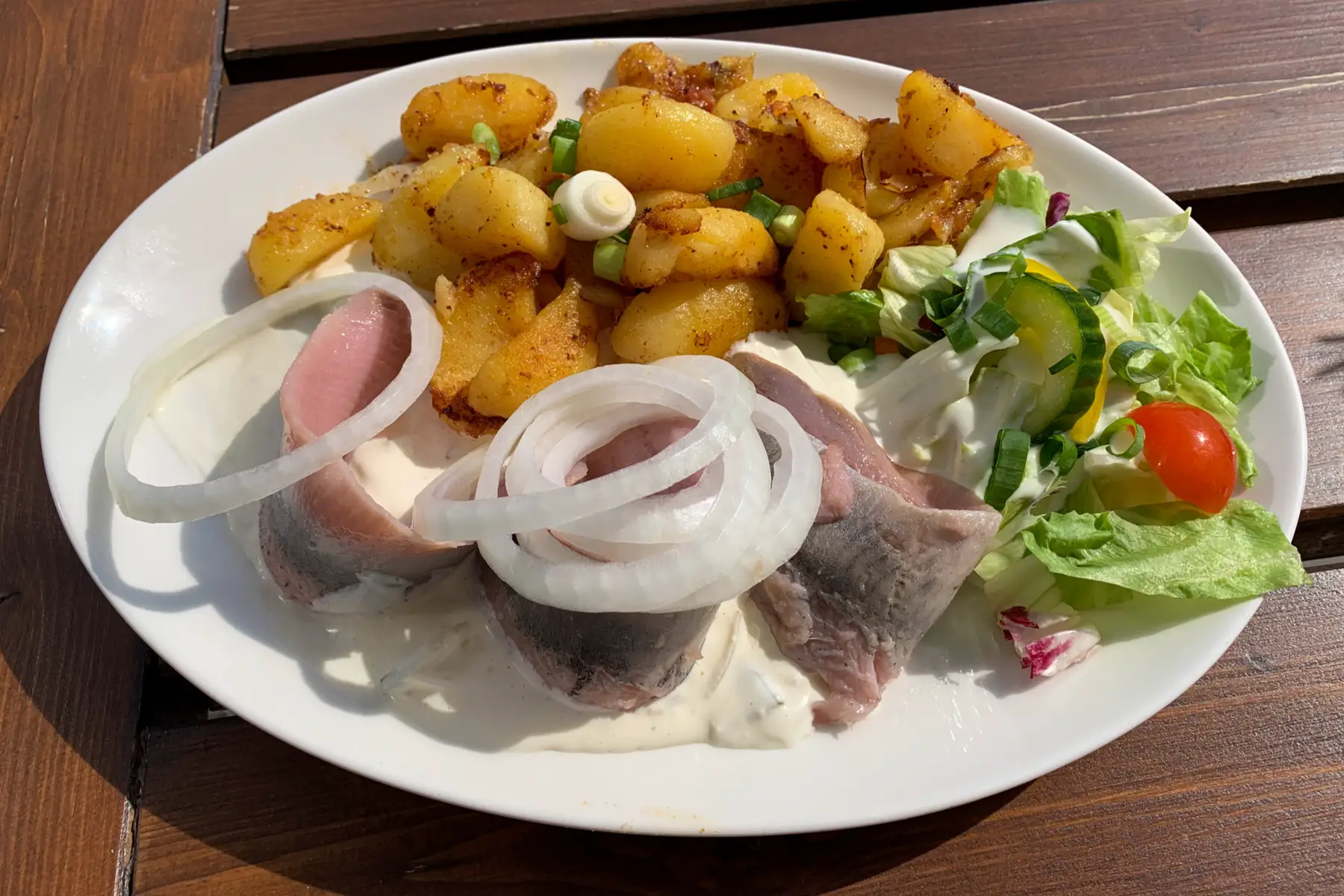
Bremen
Similar to the neighboring state of Hamburg, the cuisine of Bremen features a variety of fish and other seafood, such as the following:
- Kohl und Pinkel – kale with potatoes and sausage
- Nordseekrabben – North Sea shrimp which is often eaten with bread or in cocktails
- Curryhuhn – curry dishes, such as curried chicken, are very popular in Bremen
- Rote Grütze – Germany’s national dessert, red fruit jelly made from a mix of berries and cherries, is another Bremen favorite
Niedersachsen
The cuisine of Lower Saxony is quite similar to that of Bremen, however, it includes a variety of regional cuisines. Here are some popular dishes:
- Buchweizenpfannkuchen – buckwheat pancakes consisting of buckwheat flour, eggs, tea or coffee, salt, and sour cream. They are fried in boiled pork bacon to make flat, fatty cakes
- Handkäse mit Musik – meaning ‘hand cheese with music’, this Hessian specialty is a sour milk cheese that usually comes with a chopped onion topping
- Grünkohleintopf – this consists of kale stew with smoked meat and sausages
- Feldsalat mit Räucheraal – a tasty salad that combines field greens with smoked fish, creme fraiche, cherry tomatoes, and a bacon mustard vinaigrette
Berlin
While Berlin used to be famous for its simple and filling fare, these days, the German capital is a real paradise for foodies and fast-food lovers alike. Here are some culinary must-tries from the city:
- Currywurst – a sausage that comes with spicy, curried ketchup on top
- Döner kebab – while inspired by Turkish influences, this iconic snack actually originates in Berlin
- Hoppel-Poppel – a fun-named meal that consists of roast leftovers and potatoes, also known as a Bauernfrühsück (Farmer’s breakfast)
- Berliner Weiße – a special wheat beer that is brewed in Berlin and served either with raspberry or woodruff syrup (schuss)
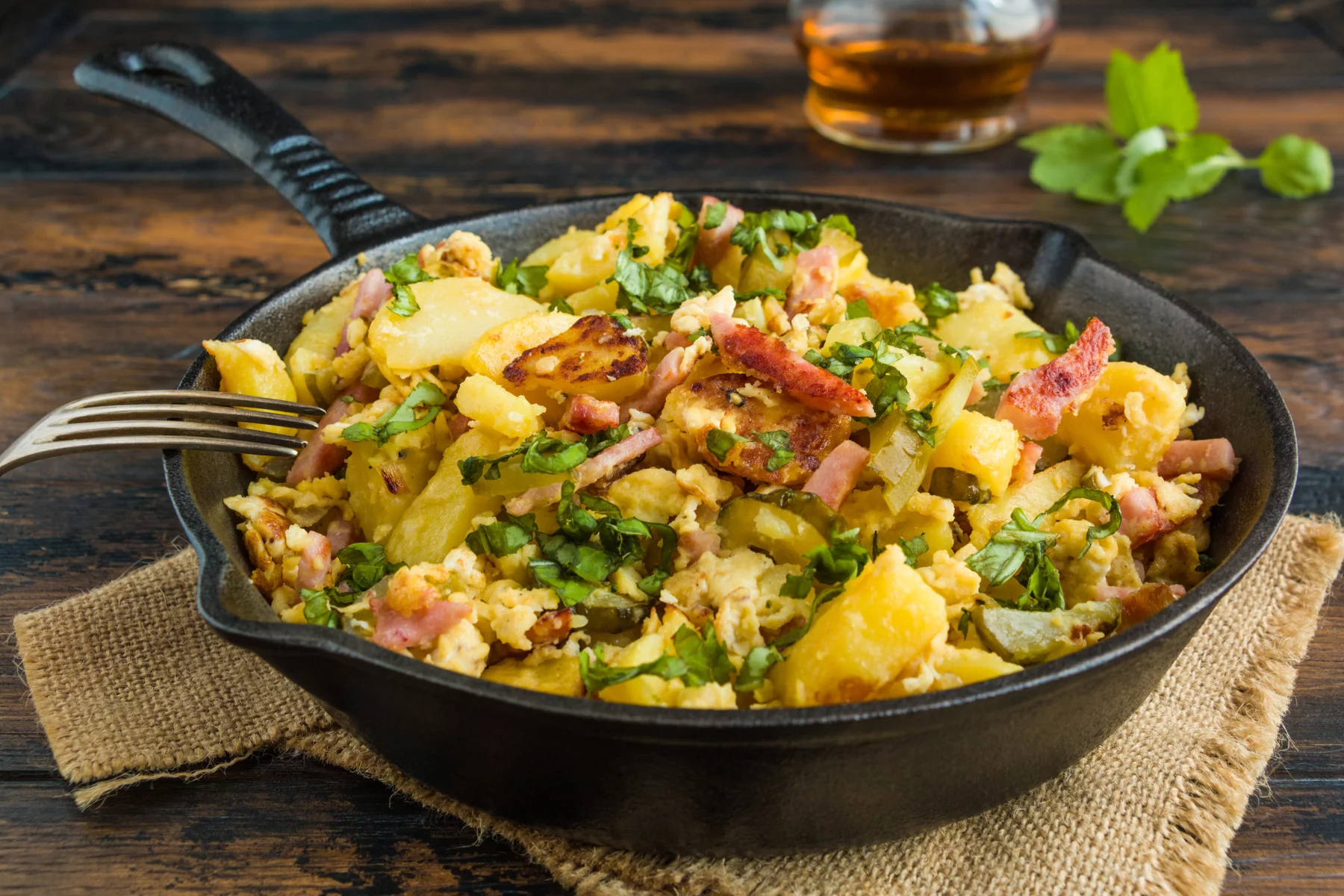
Brandenburg
The cuisine of Brandenburg includes influences from Slavonic food traditions. It includes lots of freshwater fish, potatoes, and other tuber and root vegetables. Here are some popular dishes from the area:
- Aalsuppe – eel soup
- Spargel – boiled white asparagus served with a Hollandaise sauce, boiled potatoes, and ham
- Kartoffelsalat – classic potato salad made with mayonnaise
Nordrhein-Westfalen
Nordrhein-Westfalen is Germany’s most populous Bundesland and home to people from all over the world. Therefore, you can expect to see pizza and pasta on menus across the state. That said, typical cuisine from this part of Germany focuses more on meat. The region is also famous for its white wine, from grapes that grow on the hills of the Rhine and Moselle rivers.
- Westfälische Potthucke – a dish made from potatoes and sausage
- Pffefferpothast – a stew made with beef, onions, and pepper
- Rhenish Schnibbelbohnensuppe – runner bean soup
- Westfälisches Blindhuhn – seasonal vegetables, apples, and bacon
Saarland
As one of the most Western provinces in Germany, Saarland cuisine takes inspiration from neighboring France, resulting in food that is both refined and down-to-Earth:
- Dibbelabbes – the state’s signature dish is an oven-baked potato-leek hash
- Bibbelsche Bohnesupp – bacon, onion, and potato soup
- Grummbeerkieschelscher – crispy potato pancakes
- Apfelwein or Viez – a type of cider
Rheinland-Pfalz
Rheinland-Pfalz has heavy influences from Flemish and Dutch cuisine as a result of trade ships passing through the Rhine River. Therefore, you will find things like mussels and waffles in this part of Germany.
- Saumagen – literally a ‘stuffed pig stomach’ containing a mixture of potatoes, lean pork, sausage meat, garlic, and onions
- Pflaumenstreusel vom Blech – a sweet plum streusel cake
- Kartoffelsuppe – a thick, chunky potato soup with carrots, celery, bacon, and parsley

Thüringen
Thüringen is famous for its sausages as well as its heavy and simple cuisine. Here are some must-try dishes from the region:
- Thüringer Rostbratwurst – a grilled sausage that has protected geographical indication status under European Union law
- Thüringer Klöße – a simple potato dumpling that consists of a mixture of grated raw potatoes and mashed cooked potatoes filled with crunchy cubes of bread
- Blechkuchen – while other parts of Germany enjoy tarts, pies, and tortes, people in Thüringen prefer a less extravagant, but no less delicious option – Blechkuchen, or sheet cake – which can be sweet or savory
Bavaria
When people think of German cuisine, they probably think of Bavaria. This is where many of the most famous German dishes come from:
- Schweinshaxe – German pork knuckle typically served with potato dumplings and red cabbage, or sauerkraut and potatoes
- Zwiebelsuppe mit dunklem Bier – onion soup with beer for a Bavarian Oktoberfest twist
- Bayerische Brezen – available in different shapes and sizes, most Bavarian pretzels come with salt, poppy, sesame, pumpkin, or sunflower seeds
Hesse
Although Hessen cuisine varies from region to region, potatoes and bread feature heavily on menus throughout the state. Here are some of the most famous dishes you are likely to find:
- Gekochtes Rindfleisch mit Grüner Sosse – boiled beef with vegetables and a creamy green herb and chopped egg sauce
- Frankfurter Suppe – soup made with bacon, onions, creme fraiche, herbs, mashed potatoes, and thinly sliced frankfurters
- Krautwickel – stubbed cabbage rolls
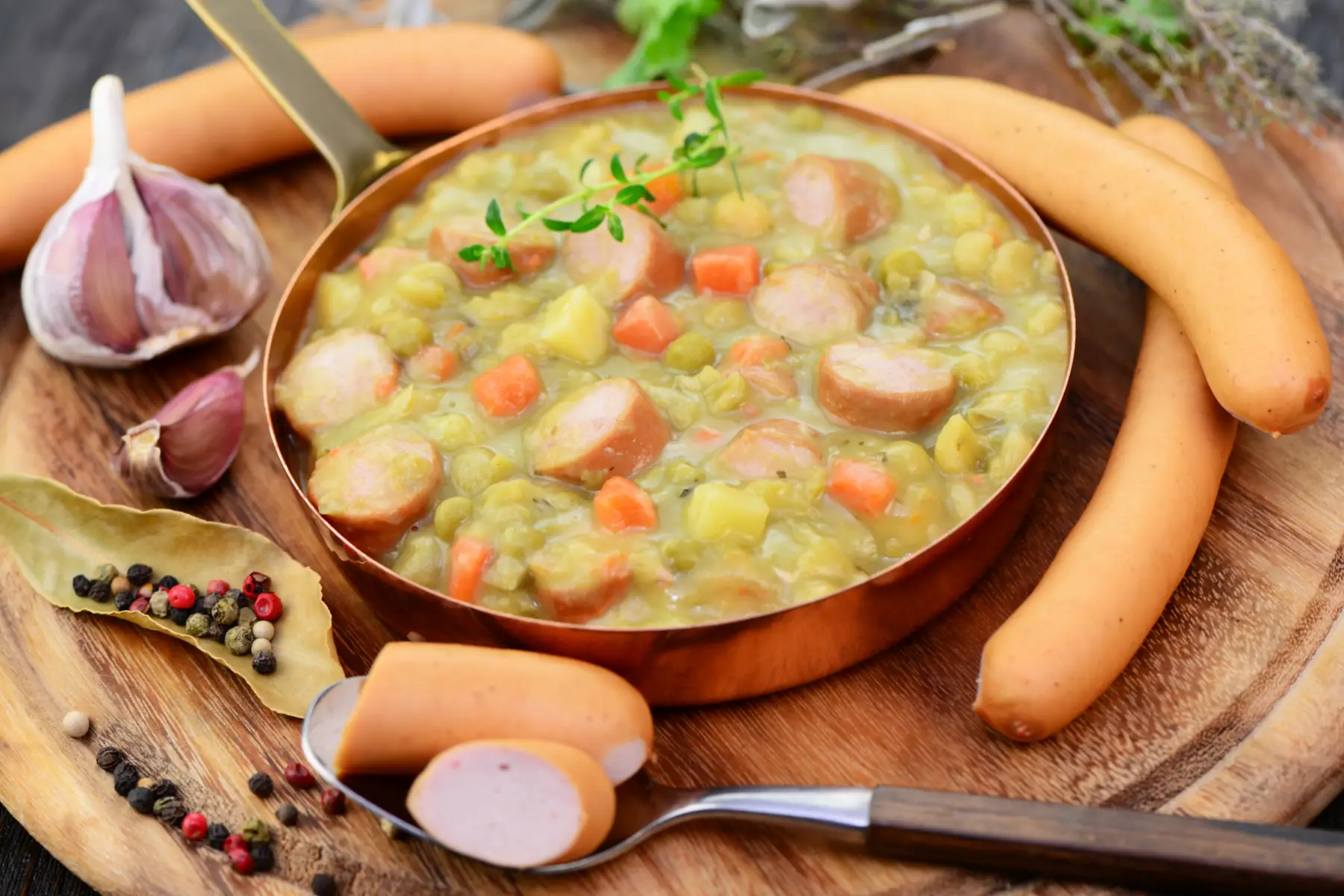
Baden-Württemberg
This part of Germany is home to Swabia and the Black Forest, and while many often ridicule it, it boasts one of the best cuisines in the country:
- Maultschensuppe – soup with Maultschen
- Spätzle – the famed German egg noodles which when served with Emmentaler cheese and fried onions, become Käsespätzle
Sachsen
Sachsen (Saxony) is another German region that boasts outstanding food traditions, of which Knödel and Klöße (dumplings) are the most famous. Sweet cakes and pastries, and heart potato dishes are also popular in the area:
- Leipzig Allerei – Leipzig’s famous vegetable hodgepodge which contains carrots, peas, white asparagus, cauliflower, mushrooms, and crayfish
- Leipziger Lerchen (lark cake) – a small shortcrust pastry, almonds, brandy, and apricot jam, in the shape of a bird; to reflect the area’s history of eating small songbirds before the ban in the 19th century
- Pellkartoffeln mit Quark – simply, jacket potatoes served with quark
Sachsen-Anhalt
Sachsen-Anhalt is famous for the quality of its produce. It is an agricultural center and a major source of wheat, oats, barley, rye, and sugar beets. It is also rich in onions, asparagus, apricots, cabbage, and dairy products:
- Baumkuchen – the aforementioned tree cake, with its spiraling layers, comes from the region and can be bought ready-made from bakeries
- Grünkohl Eintopf – a kale casserole from the region; kale mash is another popular comfort food from the area
- Gurkencremesuppe mit Kartoffeln – a soup made with potatoes, cream, milk, grated onions, and cucumber
Useful resources
- CNN – an article on why German bread is the best in the world
- ElPais – an interesting article on how Germany is leading Europe’s organic food revolution
- Deutsche Welle – an article called German cuisine: Does it exist and can you enjoy it?
- Taste of Home – discover 45 old-world German recipes worth trying
